How to Buy Your First Fountain Pen | A Step-By-Step Guide to the Best Brands
There is no item of style as overlooked as a man’s writing instrument, and perhaps none that make as much impact when it is impressive. A nice pen is an exclamation point on your image, making itself known at pivotal moments: signing a mortgage, leaving a love note for your partner, picking up the check. It is both flamboyant and sublimely professional, raising you far above the sea of ballpoint pen users.
And there is no pen cooler than a fountain pen.
You’ve seen it. You want it. And I am here to guide you through how to buy one for yourself. (For real literature geeks: I’m your Virgil to your Dante.) I have been writing with fountain pens for thirty years, in addition to running YouTube and TikTok channels dedicated to this hobby, so I’m uniquely qualified to dispense this advice.
Let’s get into it.
Picking A Pen
First off, we need to get this out of the way. This is your first fountain pen. It will not be your last. I know people who have 5 pens and 200.
I know no one who has only one.
This is because there are so many pens in so many different styles, many with different uses, and all have different nib types. There are a lot of variables here and this makes fountain pens both a little intimidating and a lot of fun. Precisely because there is a whole lot here to obsess over and to talk about. (And if you’re a left-handed enthusiast diving into the world of fountain pens, exploring options for the best pens for left-handers can enhance your writing experience and make it more enjoyable.)
Your first pen is a big deal. It will set the tone for every pen you buy after. Allow me to make some suggestions.
How to Choose A Nib
This is the name given to the part of the pen that comes into contact with the page in order to deposit ink. In other words, it’s what you write with.
Nib Materials
Most nibs come in either stainless steel or gold.
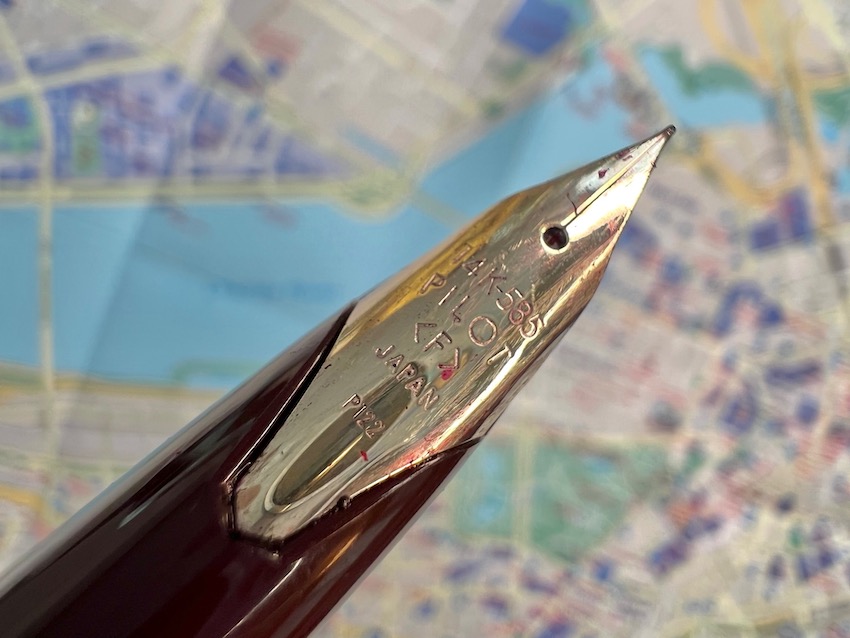
Gold Nibs
It is easy to assume that gold nibs are better, but that is not always the case. Gold is a softer and more luxurious material and so it can do some amazing things. Some pen makers do incredible things with it and some do not. There are some stiff, generic gold nibs out there that are indeed gold, but live up to none of the possibilities that this material offers.
You can make extremely soft and flexible nibs with gold. Some of these offer lovely line variation as you write.
Gold can also give incredibly smooth giving a feeling, like writing on glass. Others are sensitive to the tiny fibers in the paper, providing an interesting feeling of feedback when you write with them.
Gold nibs come in 14k, 18k, or 21k. The most common are 14k and 18k. Sometimes these are designated as 585 and 750, respectively, often on European nibs.
Some are even two-toned between white and yellow gold.
In the list of beginner pens later in this article, I included one pen with a 14k gold nib that is quite amazing and one of the finest writing experiences available.

Stainless Steel Nibs
Stainless steel nibs are on many pens up to around $200. Just because a nib is made of steel does not mean that it is inferior. There are many amazing examples out there that flow as smoothly and remarkably as any gold nib, including the ones on this list.
Some stainless steel nibs are gold colored and some look convincingly gold. Some are gold plated, which is nice but adds little to the performance of the pen, except in its resistance to corrosion. Some stainless steel nibs are tipped with gold, giving much of the smoothness of gold and the durability of steel.
The good news is that all of this is clearly marked by reputable pen dealers.
Picking a Nib Size
Here are the most common nib sizes you’ll encounter.
EF or Extra Fine Nibs
These are around 0.4mm wide. It is often stated that it is for people who write very small, but this is a bit simplistic. Extra fine means that you may draw a very fine line no matter the height of your writing.
The drawback to this nib type is that it is a bit more scratchy than the wider nibs.
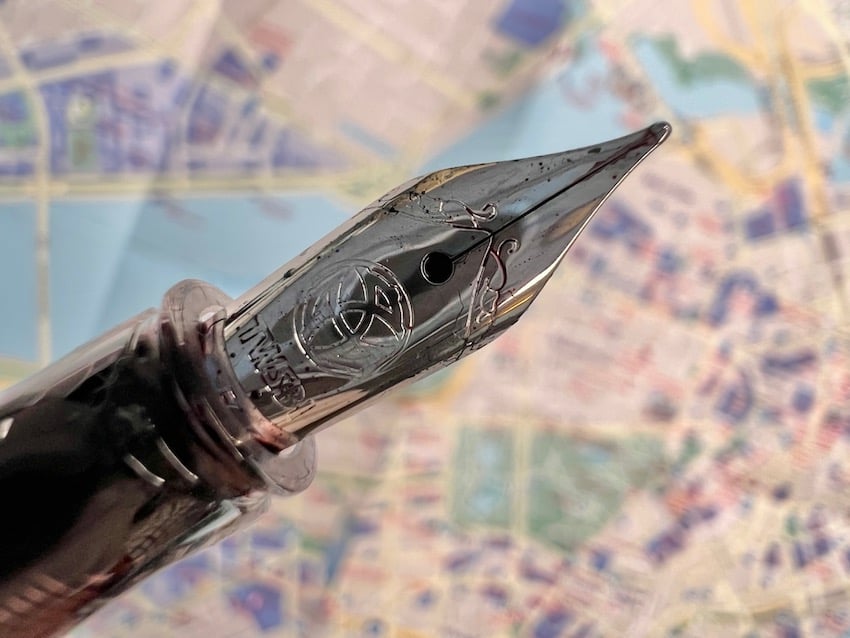
F or Fine
These are around 0.6mm wide. This would also be more appropriate for those who write smaller. It is also approximate to a ballpoint pen or a fine point gel pen’s line. This makes fine nibs a great place for those transitioning from ballpoint to fountain pens to start.
Some fine nibs can be scratchy, but there are many that are smooth and wonderful to write with.

M or Medium
These nibs are around 0.8mm. Medium is the default size and is made for average writing size and style. However, some of the most amazing nibs out there are medium nibs. They can be very wet and some feel much wider than others.
B or Broad
These nibs are around 1mm. With a broad nib you start to get into a reliably wide line. Many people use these purely for signing their names, although many write with them as well. They are better for those with larger handwriting style since they tend to have a heavier flow and some of your loops may puddle together if you attempt to write too small.
There are also many different specialty nibs, including:
- 1.1mm and 1.5mm stubs, meant to give a wide downstroke and a narrow sidestroke
- Flexible Nibs or Flex Nibs that bend and give a wide line variation from EF to Stub Width.
- Architect Nibs that give a narrow downstroke and a broad side stroke. It’s almost the converse of a stub nib. These are named after the print font style used by architects on blueprints.
- Music Nibs have two slits in the nibs that make fantastic pools of ink used to write musical notation and for some other fun line variation.
- Cursive Nibs are meant to aid in writing cursive giving a hint of line variation as you loop your way across the page.

If you are planning to write with your fountain pen every day and used for work, for note taking, journaling, etc, and you want to write small and with precision, a fine nib will work well. If you want more smoothness and a thicker cushion of ink beneath your nib helping it to effortlessly glide across the page, then think medium. Stubs are for an almost calligraphy like line.
If you plan on using your pen only to sign your name and you want to sign boldly, go with well, bold!
A Word About Wet and Dry
Fountain pen nibs are fed from their reservoirs of ink by a mechanism unimaginably named “the feed.” Some of these move a large capacity of ink through while others have less. A lot of ink denotes a Wet Nib while less is called Dry. Sometimes it ranges from each iteration of a pen making things interesting and occasionally infuriating.
A Note About Japanese Nibs
Nibs from Japanese companies, like Pilot and Sailor tend to be a bit narrower than their European counterparts.

Considering Your Pen’s Filling System
Pens need ink and one of the amazing things about fountain pens is their ability to be used and refilled. There are various methods that pen companies use to accomplish this and there are some advantages and drawbacks to each.
Cartridges
Perhaps the most common filling system is a simple, tubular, plastic cartridge that snaps on the back of the feed. You need to take the pen apart to access these. These are easy and cheap, but there are some things to consider if you decide that you want to use them.
- The Environment. The most obvious is that you now have a consumable cartridge to consider, and so you will need to carry several with you for those times when they run out. One cartridge can last a very long time, depending on how much you write. Once it does, you need to toss it and replace it with another.Now, it is possible to refill a spent cartridge with an ink syringe, but most people do not bother.
- Some Companies Are Kinda Jerks Sometimes. Some cartridges are proprietary and so you need to use ones made specifically by or for that brand. This cuts your ink choices and may affect availability.
- Limited Ink Choice. Not every bottle of ink comes in a cartridge.
-
The converter of the Esterbrook Estie fountain pen
Converters
Converters are more permanent ink filling mechanisms inside of the pen. These are replaceable, but are designed to last the life of the pen. You need to take the pen apart to access these.
An advantage of converters is that you can use them to fill a pen from any bottle of ink easily and quickly. Another huge advantage is that if one of them should break, they are super easy to swap out with another without requiring a professional repair of the pen. This cannot be said for our next two fill mechanisms.
Some things to consider with converters:
- Materials: These can be heavy-duty, made from glass and steel or other metal. They can be metal and plastic. Cheaper versions are simply plastic.
- Mechanism: Some converters use a screw mechanism, some a piston, and some a simple squeeze.The screw and squeeze mechanisms are the easiest to use with the nib immersed in ink. Squeeze converters have a rubber bladder that you squeeze to push the air out and allow the ink to be sucked in. It’s sometimes difficult to pull a piston out while keeping your nib submerged without spilling a bottle of ink.

Internal Piston Fill
Some pens utilize the interior space of the pen as the ink reservoir with a piston screw action to suck the ink into the pen.
This method is very integrated and easy since you do not need to disassemble the pen. There is a certain elegant immediacy to dipping the nib into an ink bottle and sucking the ink in. These also normally have a large ink capacity, reducing the frequency of refilling.
The drawback to these is that it is often difficult to access the internal mechanisms of these and to service them if a piece should fail. So, your pen may be out of commission for some time and finding a reputable service option may be difficult — and the repair expensive.

Vacuum Fill
Perhaps the most dramatic filling mechanism is the vacuum fill.
This utilizes the barrel of the pen as the ink reservoir and there is a plunger mechanism that you press down as the nib is immersed in ink. The air inside the pen is quickly replaced by a hydraulic whoosh of ink. This is a quick, and frankly fun, method of filling a pen.
Similar to an internal piston fill, it shares the same drawback of having to send the pen off to be repaired if there is an issue.
Eyedropper
A very simple method for filling a pen is to simply open the pen up, fill it up with ink, and close it again. This provides an enormous amount of ink.
Only certain pens may be filled this way, and are usually clearly marked as such. Sometimes a rubber gasket or some silicon grease is need to seal the threads of the pen, less the ink runs out and ruins your day completely.
Pen Materials
Pen bodies can be made from a variety of materials and each have their own qualities and quirks. Let’s run down the list.

Hardened Rubber (or Ebonite)
This is a vulcanized rubber material that is very hard and very durable, yet still retains a lot of warmth in the hand. It is also very beautiful in that you can make interesting, wavy patterns. Even when it is plain black, it can be carved and shaped into fantastic tactile finishes.
This material has been around since Victorian times. I have a Waterman pen from the 1920s made from this material and a pen from India that is brand new, and both feel amazing in the hand.
Plastic
Perhaps the most common material is plastic in all its variations and glory. It is very lightweight and tough. Some pens use ABS plastic that is nearly indestructible, while others use more brittle plastics. Plastic is cheap and there are many ways of working with it. The downside is that it can feel very clammy in your hand for long writing sessions.

Metal
Some pens are made of metal: gold, silver, copper, brass, aluminium, stainless steel, titanium, and others. Some are designed to tarnish in magnificent ways and others are meant to change as little as possible over time.
Metal is interesting and durable, but can get slick in the hand as you write, depending on the finish.
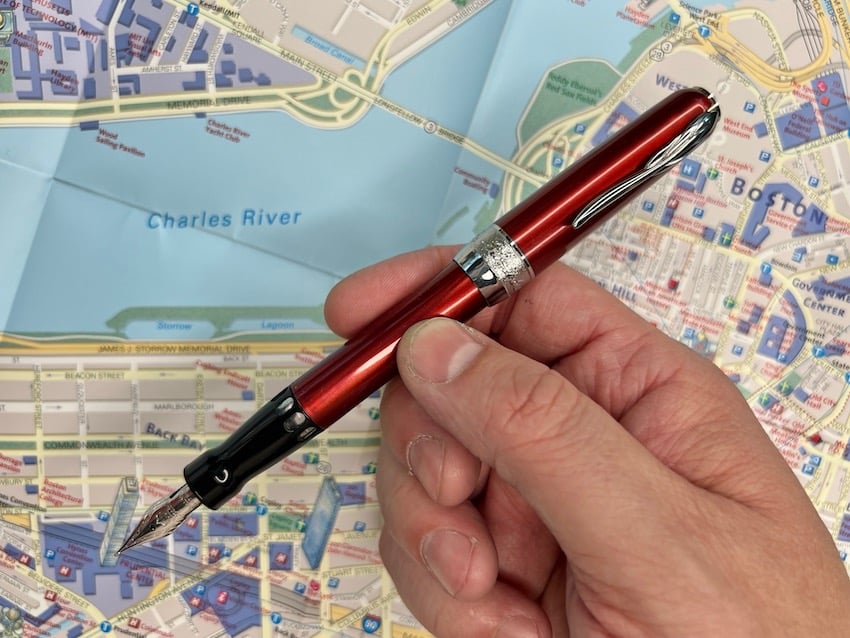
Resin
Some of the more interesting pens are made of some type of resin. Resins may be mixed with all sort of materials for different effects. Some pens use cotton and other organic materials to transmit the warmth of your hand into the pen for comfort and to reduce clamminess. Some use it to get shine or durability or depth. One pen maker uses a resin made with some volcanic dust from Mount Etna for a porous, earthy feel — and because they can.
The Cap
Picking a cap type for your pen seems like a minor thing. However, in practice, opening some pens is like assembling a hobby kit. There are many variations of caps as there are all aspects of fountain pens, but here are the basic ones:

Snap Cap
Snap caps pull off and snap on with a satisfying click. These are great since they give you quick and easy access to your pen for quick notes. You don’t want to be stumbling with your pen if you’re trying to write down your dream partner’s number! (OK, I know, you would just use your phone.)
The downside to these is that sometimes, with some pens, the cap can come off on its own. An exposed nib is a huge problem if it connects with any article of clothing. All the ink soaks in.

Screw Caps
Some pens screw off, up to three revolutions before you get the pen off. This can be exhausting if you are using a pen all day. However, some of the finest pens in the world use this method and you do get used to it.
The advantage of a screw cap is that they are less likely to work themselves off and tend to seal tighter to protect the nib and to keep the ink inside the pen wet.
No Cap
Some pens have vanishing points that snap into the interior of the pen. These are super handy, but take away some of the ritual of uncapping a pen before writing. For many, this is not a consideration. These pens are an awesome way to make a fountain pen very convenient.
To Post or Not Post Your Pen
Posting or not posting is a huge consideration that many people miss at first. Posting a pen is when you are able to remove the cap and to slide it down on the back of the pen.
Some pens must be posted, especially pocket-sized pens that are not long enough unless they are posted. Some pens cannot be posted simply because their caps do not fit. Some pens are scratched by posting them. There is a lot to consider here. Most pen companies clearly mark whether a pen can be posted and what the consequences are if you do.
Generally, check the inside of the cap where it makes contact with the pen and make sure that it is not metallic or could otherwise scratch your pen.
If you do not post a pen, keep track of the cap lest it fall, rolls away, or shatter.
Choosing Your Pen Size
Pens come in a variety of sizes including micro pens that can disappear into a pocket, standard size pens, and large girthy pens for larger hands. It is always best to try one before buying, if you have an opportunity. https://goldspot.com/pages/best-pens-for-lefties-that-dont-smudge
The Best Beginner Fountain Pens
Now that we know what to look for, let’s shop for some pens.
Best Value Beginner’s Fountain Pen: TWSBI Eco ($35)
For $35, you cannot beat the price and performance of the TWSBI Eco.
Why a TWSBI Eco?
The TWSBI Eco gets to the essence of everything great about writing with fountain pens.
It is an internal piston filled pen. This means that the body of the pen, the barrel, acts as the ink reservoir and you suck up ink through the feed hole under the nib from any bottle directly into the pen. You can actually see it sloshing around in there.
In fact, the barrel is clear, so your pen takes on whatever color of ink you choose for it. This is super fun and very distinctive, immediately drawing attention to the fact that this is not your ordinary pen. It’s much more fun seeing how the ink works its way down into the feed and to the nib.
Most of all it has an amazing writing experience. Making the transition from a ballpoint or a rollerball, I would suggest that you buy the TWSBI Eco in the demonstrator model (Clear) with a fine nib.
The one consideration with this pen is that it screws on and off, meaning that you will have a lot of twisting and turning in the course of a day. Nevertheless, the experience of writing with it makes up for its shortcomings. Its Jowo nib is always reliable and I have never had an issue with the four I own. You can also swap the nibs out very easily if something ever happens to it.
This pen does not come with ink and so you need to buy a bottle. Some of my favorites available with purchase are
- Diamine Oxblood: an incredible, visceral red that will make your script distinctive, but will never look like the color red that your teacher lavished on your math homework!
- Sapphire: This is a vibrant blue that looks jewel-like upon the page. Why write when you can shine?
- Namiki Black: There is no basic black here. Namiki Black is a lovely cloudy black ranging from deep charcoal to obsidian. It also comes in one of the most stylish bottles that looks like it came from a tea ceremony.
TWSBI Eco Pros
- Fantastic value.
- Amazing nib; as good as any at any price and it is replaceable .
- Fills from a bottle with an internal piston fill system that is easily serviceable.
TWSBI Cons
- There is a learning curve in how to fill it.
- It’s not the prettiest pen.
- It has a screw cap.
Best Pen for the Office: Pilot Metropolitan ($18)
The Pilot Metropolitan is an amazing value at $18. This pen features a very modern and sleek design with a cap that snaps with a satisfying click. This is a pen that is perfect for the business world. It comes in a wide range of colors and patterns, but looks especially powerful in black or silver.
The snap cap makes it excellent for quick note taking since there isn’t all that twisting and turning to get to that excellent reliable Pilot nib. Pilot nibs tend to be thinner than their European counterparts, so a Pilot Fine will feel like a German Extra Fine. You may want to order a medium nib for this one.
This one comes with a basic squeeze converter that is basic in its design, but effective. It is already installed so you can get filling from a bottle right away. If you want to use cartridges, you have to use Pilot proprietary cartridges, one in black is included. These come in 10 colors, which is expansive, but if you use the squeeze converter you have access to any bottled ink, which is preferable. This is a huge part of the fun.
The best thing about this pen is that it is relatively inexpensive, but does not compromise on style. It has the feel and look of a much more expensive pen.
Pilot Metropolitan Pros
- Great Value
- Looks much more luxe than it is
- Great writer
- Snap Cap
Pilot Metropolitan Cons
- Squeeze converter
- Nibs run narrow (be aware)
- Proprietary cartridges
Best Easy to Use Fountain Pen: Lamy Safari ($20)
There are few fountain pens as iconic as the Modern sculptural design masterpiece, the Lamy Safari.
This German made pen features Wolfgang Fabian’s sleek squarish 80s design with a carved ergonomic handgrip, an oblong ink window, a wedge of a nib, a snappy looping clip on a round snap-on cap, discordantly placed on a faceted body. An oversized logo slants away from the forward motion of the design embedded into the ABS plastic, the same material used to make Lego.
This pen has a tough, Casio G-Shock-like-quality and you can easily toss it into a bag without it getting damaged. I imagine you could also see it in a museum, at an exhibit on the best of modern design along with the Olivetti 22 typewriter, the Chevy Corvette, and the Clamshell iBook. It is that versatile.
This pen can be democratic and exclusive. It has the ability to adapt to its surroundings yet stands out when noticed. This is a feat for a pen that costs $20 on Amazon.
This is a pen for an architect, a creative writer, someone who appreciates great design, and rugged materials. It’s also just a brilliant writer, with a very consistent nib. (Again, if it’s your first, I recommend a fine nib.) It also comes in a rainbow of colors, including a few special edition ones each year. I recommend either white, black, or charcoal to keep it cool and subdued.
The pen comes with a cartridge poised for action. A small sleeve of cardboard separates the grip section from the barrel; remove this piece and screw the pen back together and the cartridge is forced against the feed, piercing it, and preparing it for use. If you want to fill from a bottle, you need to purchase the Z28 converter separately.
Lamy Safari Pen Pros
- Stylish (but polarizing!)
- Tough ABS plastic
- Great nibs that are very easy to replace
- Snap cap
- Easy set up
- Fantastic value
Lamy Safari Pen Cons
- Z28 Converter is sold separately
The Best Overall Fountain Pen: Pilot Custom 823 ($230)
If you are one of those people who feel that it is better to buy something once rather than buy a bunch of inferior versions, If you would skip right over Seiko, Oris, Omega, and buy a Rolex, then I have the pen for you.
Sure there is Montblanc, but the aficionado’s fountain pen, the one that will inspire knowing nods from other users, is the Pilot Custom 823 and the most beautiful version is the one in Amber..
At $230 on Amazon, this is our most expensive option. Remember, you can spend as much as you like for a fountain pen, but once you have the Pilot Custom 823, you could purchase another pen, but you never need to.
This pen has a vacuum filling system that is very efficient and dramatic, making an incredible hydraulic whooshing sound as the ink floods in. It has a large capacity for ink and is translucent so you can see how much ink remains. It only fills from a bottle.
One important thing to remember is that the vacuum fill needs to be vented. All you do is leave open the twist seal of the fill mechanism while writing. Otherwise, you only have the ink in the feed to last you and this is only enough for a few pages. Even pros sometimes forget, so if you are ever writing with it and it seems to run out of ink while you can clearly see that there is plenty in there, just unscrew it about 2 to 3mm.
One of the positive attributes of this filling mechanism is that it is perfect for flying. Sometimes changes in air pressure can make fountain pens leak a little ink through their nibs, but this pen seals at the feed and so no air builds up behind it. There is usually plenty enough in the feed for one flight.
Its 14k gold nib is a work of art and gives one of the most pleasant writing experiences available at any price: smooth, but with a touch of texture from the paper so that you still feel a connection there. Amazing.
When you write with the Pilot Custom 823 you are very aware that you are writing with a luxury pen and so is anyone else who notices.
Pilot Custom 823 Pros
- One of the best fountain pens at any price
- Vacuum fill is fun and effective
- 14k gold nib is a work of art
- Great to fly with
Pilot Custom 823 Pros
- Wicked expensive (but worth every penny)
- Delicate cap

Wrapping Up
You cannot go wrong with any of these pens. Your choice of pens is personal and unique to you. If it were me and I were a beginner, and if I wanted the whole fountain pen experience, I would go with the TWSBI ECO. It is an amazing pen with a fantastic nib and the demonstrator quality is very fun and interesting. If I wanted a design icon that makes it easy to write right away, I would go for the Lamy Safari. If I wanted to skip the starters and get to the main course and dessert — the best pen you can buy — it’d be the Pilot Custom 823. Whatever you choose, the right option is waiting for you in this article.


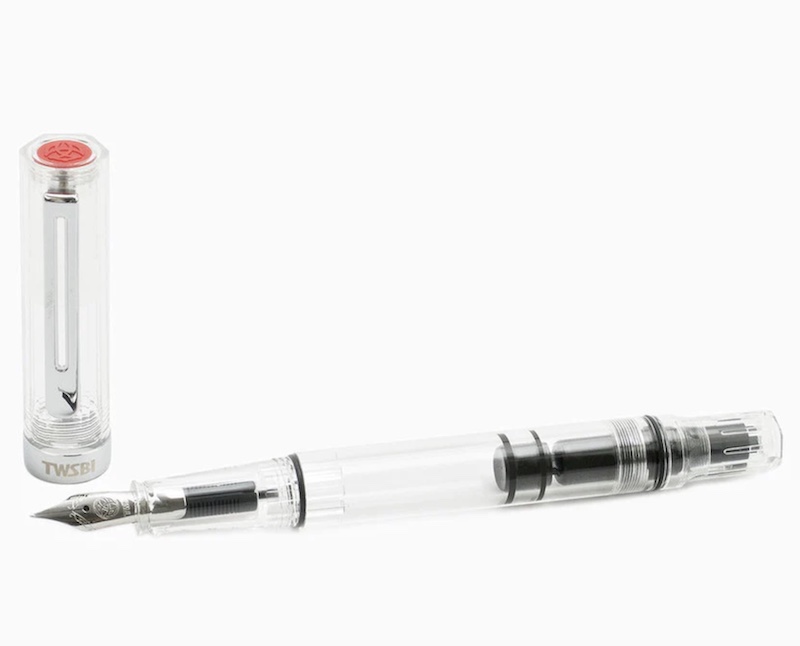
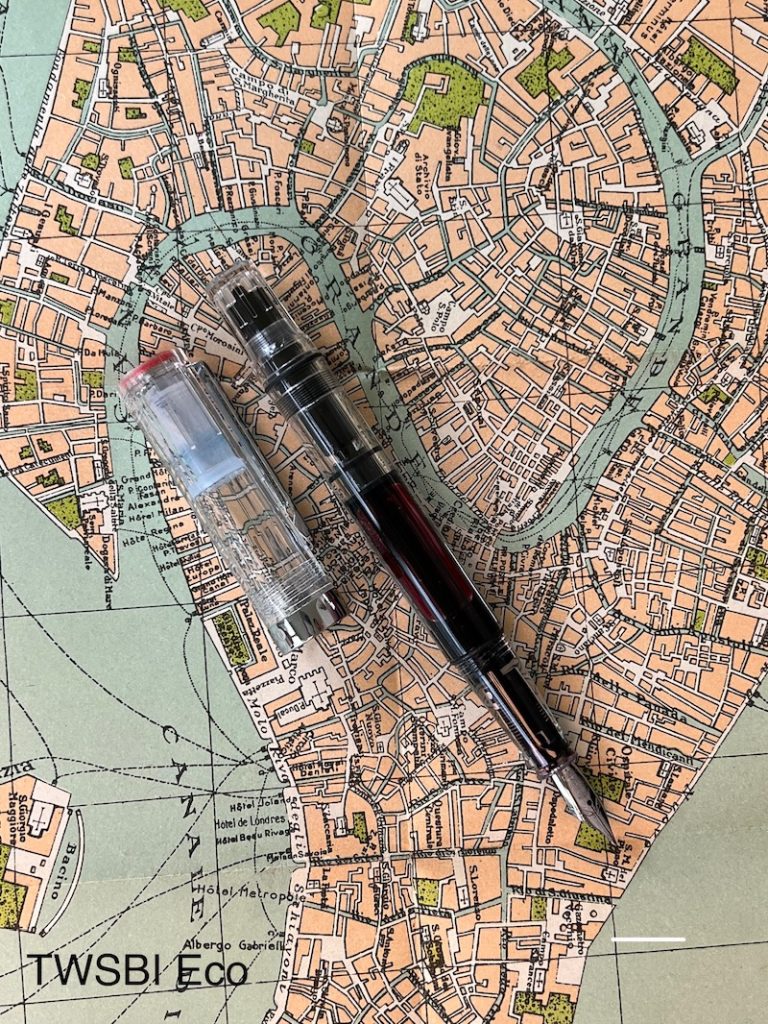





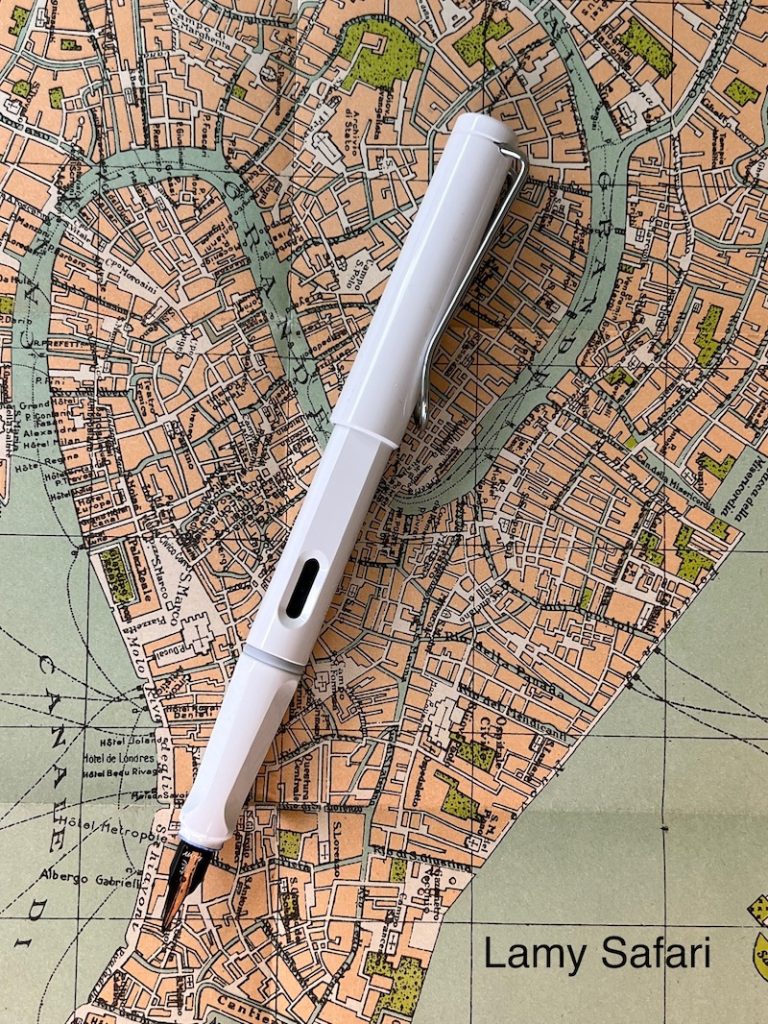






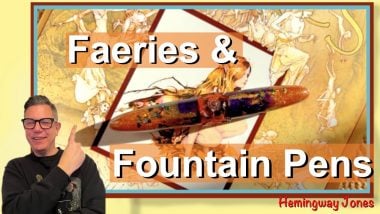



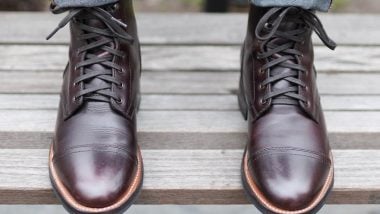


Join the Discussion